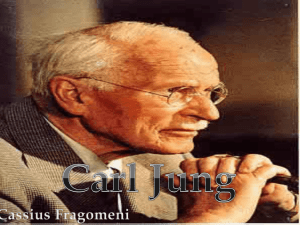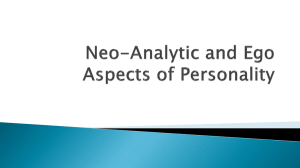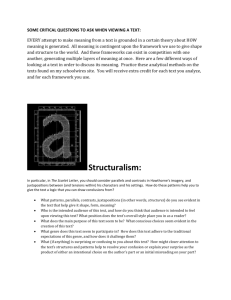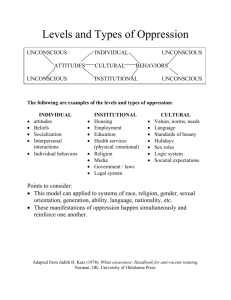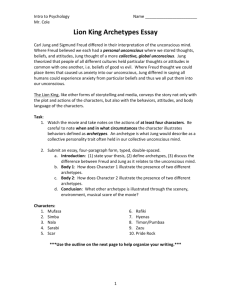Chapter 12—Personality Theory
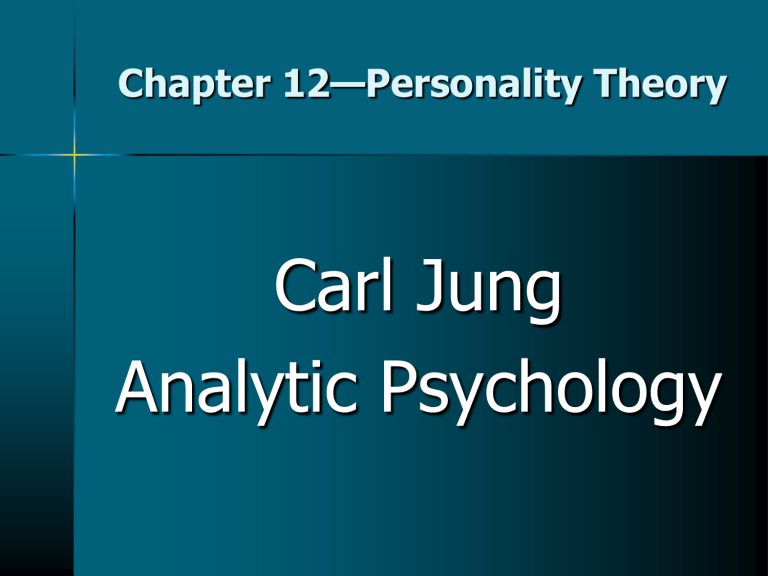
Chapter 12—Personality Theory
Carl Jung
Analytic Psychology
Carl Jung—Introduction
Originally trained with Freud
Broke from Freudian analysis
Event Freud and Jung analyzing each others’ dreams
– Freud showed resistance to Jung’s analysis
– Freud stopped, saying he would lose authority
Felt Freud overemphasized sexual aspects
Experience with developing sciences of
Anthropology and Sociology
Spent time living in different cultures
Introduction—
Basic Principles
(part of his theory)
Principle of opposites: Our personality consists of opposing/competing forces that we strive to balance.
– Examples
Conscious versus unconscious
Introversion versus extraversion
– Opposition creates energy (concept of energy is similar to Freud’s libido)
Propels movement forward
Introduction—
Basic Principles
Principle of equivalence: Energy created by opposites is given to both sides equally.
– Each pair in opposite has = amts of energy
– Increase in one area pulls energy from other area
– Too much on one side =>
May spur growth
When problem, complex is said to develop
Introduction—
Basic Principles
Principle of entropy: Tendency for opposites to come together—be less extreme opposites
– When younger, degree of opposites tends to be extreme
– As one grows, able to tolerate differences/opposites
(doesn’t have to be one or the other—can be both)
– We strive toward balancing these opposites
Natural tendency for growth
Balance not free of conflict
Individuation = term used for goal of unity of our personality (unification of opposing forces into whole)
Core Concepts—
Ego
Ego = conscious mind
– Center of consciousness
– Characterized by one dominant attitude
(introversion/extraversion)
– Characterized by two functions:
Thinking or feeling
Sensing or intuiting
Core Concepts—
Personal Unconscious
Personal unconscious
– Similar to Freud’s conception of preconscious and unconscious
– Contains memories that can be recalled as well as those that have been repressed
– Complex: cluster of emotionally-charged memories that influence behavior
Arise from need to adapt and inability to meet that need/challenge
Develop over time
Examples mother complex, guilt complex, hero complex
Identified through word association tests
Core Concepts—
Collective Unconscious
Collective unconscious
– Definition—Psychological residue of man’s ancestral past
Reservoir of mankind’s experiences as species
Accumulated memories of mankind’s experiences
Seen in themes and symbols in cultures (why we respond to them):
– Parallels in myths, fairy tales, literature, art, etc.
– Dreams
– Déjà vu experiences
– Near death experiences
Core Concepts—
Collective Unconscious
Collective unconscious (cont’d)
– Archetypes: inherited predisposition to experience things in certain ways
More like an emotion
Jung described them as “thought-forms” implied as much feeling as thought
Unlearned tendencies to experience things
Organizing principle (similar to Freud’s conception of instincts) for our behavior
Collected deposits of mankind’s repeated exp’s with events such as birth, death, mother, father, evil, etc.
Core Concepts—
Archetypes of Coll. Uncon.
Main archetypes of collective unconscious
– Persona: public personality (mask) worn to win society’s approval
Our instinctual knowledge that we have to act certain way in society
Way we present ourselves
The good impression we hope to make
Starts as archetype, but becomes farther removed from collective unconscious
Comprised of attitudes taken from social class, occupation, ethnic heritage, religion, etc.
When people associate entire personality with persona potential problems
Core Concepts—
Archetypes of Coll. Uncon.
Shadow
– Lower, animal side of our behavior
– Represents socially unacceptable beh
– Derives from prehuman, animal past—when we were not self-conscious
– Dark side evil we are capable of
– Shadow is amoral
– Also has positive side spontaneity, creativity, healthy mistrust, humor
– Where do we see shadow? Dreams, fantasies, slips of tongue, jokes, etc.
– Symbols snakes, monsters, demons, etc.
Core Concepts—
Archetypes of Coll. Uncon.
Anima/Animus
– Anima = female archetype in males
Animus = male archetype in females
– Spirit of opposite sex in us
– Trace of mankind’s experience of living with opposite sex
– Societal stereotypes and expectations cause us to develop only half of our potential
Core Concepts—
Archetypes of Coll. Uncon.
Self
– Center of psyche
– Represents our striving for unity of opposing forces
– Most central and influential archetype
– Represents transcendence of opposites—all aspects of personality expressed
– You are neither and both persona and shadow, neither and both conscious and unconscious what comes together is self
Core Concepts—
Archetypes of Coll. Uncon.
Self (cont’d)
– Individuation = process by which ind integrates opposing tendencies
Indivisible
Contradictions do not overwhelm
– Personified by Jesus
Christ and Buddha
– Perfection only completed at death
– Symbolized in mandala
New Topic—
Theory of Psychological Type
Introduction
– Attempt to explain individual differences
– Began with concepts of introversion and extraversion
– Added functions (thinking-feeling, sensingintuiting) later
– Represents preferences rather than exclusive talents
– Myers-Briggs Type Indicator
Psychological Type (cont’d)
Attitudes (orientations): our tendency to act in certain; how we orient to the world
– Introversion:
Oriented toward inner world (Object ego)
Prefer inner world of thoughts, feelings, dreams, etc.
Focus on concepts, ideas, internal expressions
More oriented to collective unconscious and archetypes
Psychological Type (cont’d)
Attitudes (cont’d)
– Extraversion
Oriented to outer world (Ego object)
Prefer world of things and people
Focus on others and thinks aloud
More oriented toward persona and outer reality
Psychological Type (cont’d)
Functions: mental activity
– Perceiving: how we gather or take in information
Sensing:
– Pay attention to observable facts or events through five senses (seeing, hearing, touching, etc.)
– Good at looking and listening
Intuiting:
– Focus on meanings, relationships, possibilities
– Unconscious sensing—knowing w/o sensing
– Unconscious processing
Psychological Type (cont’d)
Functions (cont’d)
– Judging: how we come to conclusions about what we perceive
Thinking:
– Decide impersonally on basis of logical conclusions
– Tell what it is
– Evaluates information rationally
Feeling:
– Decisions based on personal and social values
– Tell what it is worth
– Evaluates by looking at overall picture
Psychological Type (cont’d)
Types (see MBTI and handout)
– Each type represents preferences for one over the other
– Dominant function => function used most enthusiastically
– Development and type
Youth and adolescence
– Develop dominant function >
– Most natural – feels most comfortable
Midlife
– People tend to be motivated toward completion of personality
– Begin to add neglected functions

